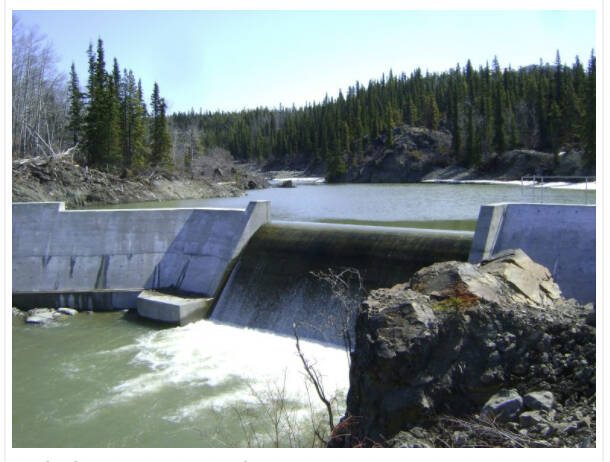Proximity to new, large infrastructure projects makes community people nervous. With residents of quiet Atlin, British Columbia, sitting next to an impending construction project worth $245 million for two power plants and a 92-kilometre transmission line starting on the outskirts of their historic town, nerves are understandable.
The Atlin Board of Trade called a meeting on Jan. 4. It drew close to 40 people out of their homes to listen to more sides of the project.
This meeting followed several information sessions that had been offered by the proponent over the last five years. Peter Kirby, the project proponent’s CEO of the Tlingit Homeland Energy Limited Partnership, said some of the earlier meetings were very well-attended, and others not.
Project years in the making
The planning and development phases of the Atlin Hydro Expansion project have been underway for some time. For many years the Yukon Energy Corporation (YEC) has been actively seeking new sources of renewable energy with proximity to its isolated Yukon grid to address seasonal shortfalls. They have come to focus on opportunities in the Southern Lakes region and northern British Columbia.
YEC’s 10-year Renewable Electricity plan includes purchasing electricity from the Atlin Expansion project, developing pumped storage at Moon Lake, and extending and upgrading the Southern Lakes transmission line network between Atlin, Carcross, Skagway, Jakes Corner and Whitehorse.
YEC is pursuing an agreement with the City of Skagway to provide summer electricity to Skagway to support cruise ships and meet their seasonal electrical demands. A three-page MOU to this end was on the agenda for Skagway’s council on Jan. 6.
The Yukon Development Corporation reports they have been working since 2020 to find funding support for the Atlin project. Peter Kirby, CEO of the Tlingit Homeland Energy Limited Partnership said he expects the project to be funded with contributions from both the Yukon and the federal governments, along with significant loans. The Yukon’s department of finance indicated that Yukon figures will be in next year’s budget and five-year capital plan.
In April 2021, Canada announced a federal grant of $3 million towards the projected project cost of $3.5 million for the hydropower expansion facility in Atlin.
In late May 2021, SNC-Lavalin announced “they had been awarded a design and engineering contract by Tlingit Homeland Energy … to support additional power capacity for the local hydro facility in Atlin, BC.”
The Atlin project was submitted to B.C.’s project review process in August 2021 and is currently in the technical review phase, which includes receiving public comments until Feb. 1.
The Yukon portion of the project, the transmission line between Jake’s Corner to the British Columbia border, recently cleared YESAB and the Teslin designated office recommendation has been sent to federal authorities for final approval.

Atlin residents flag proximity, changing plans
The Atlin Hydro Expansion Project is led by the Tlingit Homeland Energy Limited Partnership (THELP), which is fully owned by the Taku River Tlingit First Nation. The project is billed to make dependable renewable electricity available in Yukon. All power produced in the facility will be sold to the Yukon Energy Corporation. The revenue will accrue to the Limited Partnership and the Taku River Tlingit First Nation.
The project will increase the energy production at the existing Atlin hydro facility from 2.1 to 10.6 megawatts by expanding the ‘upper’, existing powerplant and building a new, ‘lower’, powerplant.
To accomplish this increase in production, the storage range of Surprise Lake will be increased between 0.7 and 0.9 metres. The two powerhouses will depend on controlled flows through penstocks and canals along Pine Creek. Project documents indicate that some wetland and fish habitats will be negatively affected.
Heather Kenny, an Atlin resident, said she didn’t think that people were against the project, but they were “against the location of the second power house” and its proximity to residents and recreational areas.
Kirby said that yes, some residents will see the power plant and the clearing from their homes, but the company was making good efforts to mitigate the sightlines.
For instance, the company has decided to bury the four kilometres of powerline between the two plants so it will be out of sight.
“This is a significant financial impact on the project that we’re prepared to make in order to help maintain as much harmony as we can in the community,” Kirby said.
Some of the community frustration appeared to stem from the iterative nature of the planning process, and that some things had changed from the original proposal and had shifted as designs were adjusted. Kirby said the buried transmission line was a good example of how the changes are actually improvements.
The Atlin Hydro Expansion project is not a simple undertaking. It is situated on the unceded and overlapping of traditional territories of three First Nations, the Taku River Tlingit, Teslin Tlingit Council and the Carcross Tagish First Nation. The project needs to work with review process in British Columbia and the Yukon, and final approval rests with a federal decision body for the Yukon portion of the transmission line through YESEAB and a provincial decision in B.C. All coupled with the fact that the project is needed to meet Yukon’s winter energy needs, not Atlin’s, nor B.C.’s, and feeds a small, isolated electrical grid.
Kirby believes the project is necessary to reduce the use of fossil fuels. Yukon Energy says that this project is akin to adding another 8 to 10 per cent to its current capacity or enough to meet the electrical needs of an additional 3,700 Yukon homes. They contend it is a well-needed project to provide clean, renewable energy in the territory.
Contact Lawrie Crawford at lawrie.crawford@yukon-news.com
